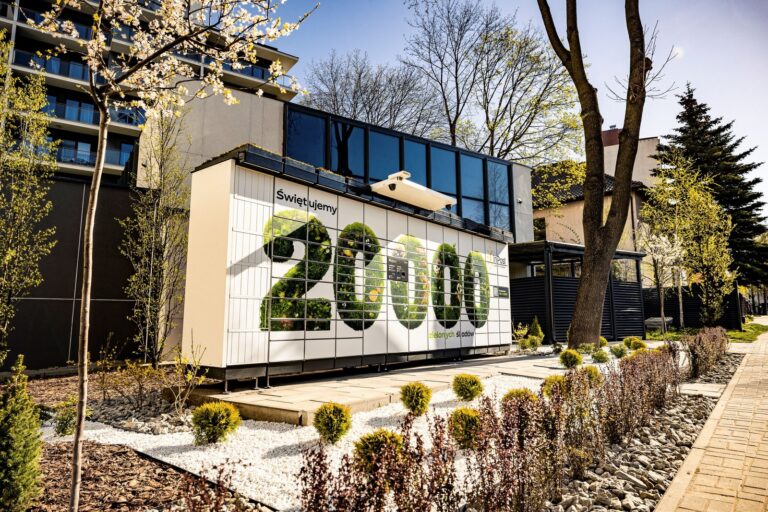In Poland, almost three-quarters of all deliveries now go to lockers. Lockerland, as we like to call it, is a logistics paradise with companies continually striving to improve efficiency and margin. This is a country where one delivery vehicle can deliver up to 1,500 parcels per courier per day, as InPost claims in its recent ESG report. That’s 10 times more parcels than via ‘classical’ door-to-door delivery.
It is therefore no wonder that there are now seven competitive networks with over 31,000 automatic parcel machines (APMs) on the ground. While InPost still maintains a dominant position, around one-third of lockers are now run by competitor networks.
As we look at things, though, the business results of InPost – the operator most admired for its unbeatable customer experience – are nothing less than incredible. This player has moved from being virtually bankrupt less than a decade ago to achieving EBITDA of well over 40% in its Polish operations.
Moreover, InPost is not losing market share (based on the H1 2023 report). It is actually growing by 19% YoY. What’s truly amazing is that while already being the leader, InPost grew in Poland by 15% versus Polish e-commerce parcel market growth of some 9% YoY (InPost 1H results 2023).
The question thus arises as to how it is possible for InPost to grow and not to lose revenue when competitors have managed to build a network one-third of InPost’s size and every 5th APM stands no further away than 50m from an InPost machine?
While this can partly be explained by first mover advantage and the fact that InPost’s competitor networks are not open and consolidated, meaning that even the largest of them is several times smaller than the leader, there are several other important factors that need to be considered. The most important is the unique differentiator of InPost – its powerful customer experience (CX).
Everything starts with affordances and the understanding of human nature. We all love Apple’s approach in which traditional user instructions are no longer needed. According to Don Norman, the man behind the term ‘user experience’, “When affordances are taken advantage of, the user knows what to do just by looking: no picture, label, or instruction needed.”
Indeed, InPost has made CX its core brand differentiator. One of its signature services is label-free dispatch. Indeed, who wouldn’t prefer to go to the APM with a pen and a label and who has a printer at home with a ready-to-stick label?
InPost has made it its business to work in a very Amazonian way and question all ‘unpractical’ rules and requirements from a customer perspective, instead setting up its own simple and ‘out of the box’ standards.
It is unusual for logistics companies to refer to emotions but as InPost proves, this approach really works. The tone of voice and service design is exceptional. As Jacek Powałka, partner at Last Mile Experts and former customer experience director at InPost, explains, “The key is understanding the true power of brands like Apple, Amazon or latterly, InPost.”
Subconscious, irrational reactions to brands have been examined by the research of professor Gavan Fitzsimons from Duke University. His study found that after being subliminally exposed to the Apple logo, compared to the IBM logo, research participants actually performed better at creative tasks. The argument here is that Apple has been repeating, over and over again, that it is the brand for creative and cool people. InPost aspires to do the same.
Logistics brands are mostly about trust and InPost – in Poland – has certainly become one that you’d feel happy to be a friend with; or even like an older brother who is your role model and hero. Once a consumer identifies how to behave with a brand, it actually shapes the way they behave.
In turn, loyalty to InPost over other Polish parcel locker offerings has been proven in research, where 37% claim no willingness to try any other, even if it is cheaper and both are located the same walking distance away.
The only exception from the main Polish APM competitors is One Box by Allegro, which according to one piece of research, has even been able to gain leadership over InPost in categories such as innovation, ecology and visual attractiveness, as found by Fundacja Stocznia (CATI on representative sample of 1,500 e-shoppers, 2023). Interestingly, Last Mile Experts’ partner – Jacek Powałka helped design both companies’ unique customer and brand experience.
The question that almost all of our clients ask is “How can we create demand for APMs on merchants’ sites?” or “How can we change perceived value to drive e-shoppers to switch to APMs for good?” Finally, the more engaged clients ask, “How can we integrate all touch points in mobile app, parcels tracking, courier interfaces, customer care and marketing communication to build a loyal and trusting customer base?”
While this article doesn’t offer scope to cover this in detail, there’s a strong mental correlation between brands and emotions. Players such as InPost or Allegro One have been able to offer ‘ready to use’ recipes to successfully leverage this correlation.
InPost claims in its last report that 80% of online shoppers actively select delivery to lockers only. This is the power of the customer experience strategy built into brands that can influence our behavior to an extent far beyond the point of sale. This is an area that is woefully neglected in the last mile and for this reason Last Mile Experts has created arguably the only dedicated last-mile CX workshop, using the skills and experience of the man who helped create the secret sauce that made InPost great.



